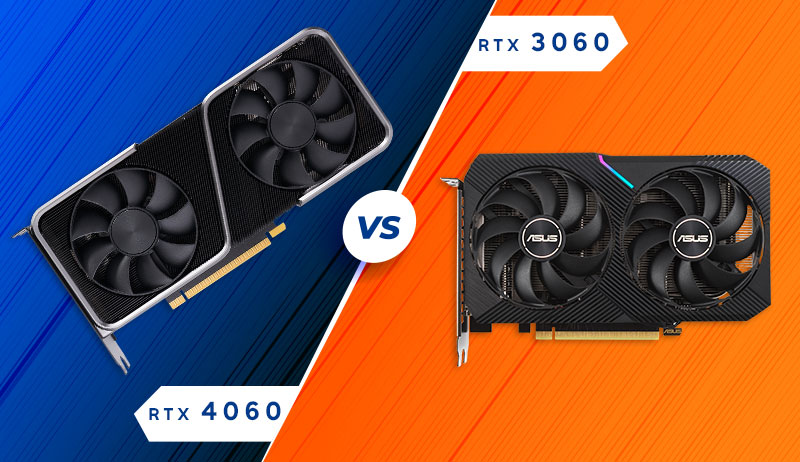
Over the years, NVIDIA has released several graphics processing units (GPUs) for gaming pc and laptops. Below in this guide, we'll compare the RTX 3060 and RTX 4060 graphics cards.
NVIDIA's GeForce RTX 4060 graphics card is scheduled to debut in 2023. The card supports DirectX 12 Ultimate and is based on the AD106 graphics processor. This guarantees that GeForce RTX 4060 will support all current games. Moreover, the DirectX 12 Ultimate capability ensures that subsequent video games will include hardware raytracing, variable-rate shading, and other features.
On January 12th, 2021, NVIDIA released the GeForce RTX 3060, a graphics card that is a performance segment graphics card. This graphics card supports DirectX 12 Ultimate and is based on the GA106 graphics processor in its GA106-300-A1 variant. It is manufactured using an 8 nm process. This means that GeForce RTX 3060 will be able to run all current games. Additionally, the DirectX 12 Ultimate capability ensures that upcoming video games will support hardware raytracing, variable-rate shading, and other features.
General performance metrics such as the number of shaders, the base and boost clock speeds of the GPU cores, the manufacturing process, texturing, and calculation speed. These metrics indirectly describe performance. This guide will show a detailed specification comparison of RTX 4060 and RTX 3060.
NVIDIA's GeForce RTX 4060 vs. NVIDIA's GeForce RTX 3060 Specification Comparison
NVIDIA's GeForce RTX 4060 Specs:
Graphics Processor
The RTX 4060 uses Ada Lovelace architecture and is based on the AD106 GPU. It is manufactured using a 4nm production process, and its die area is 190 mm2.
Board Design
The RTX 4060 graphics card has dual slots, a 1 x 12-pin power connector, and a maximum power draw of 200 watts. It has 3x DisplayPort 1.4a and 1x HDMI 2.1 for displaying outputs.
Clock Speeds
This graphics processing unit (GPU) runs at a base frequency of 2505 MHz, which can be increased to 2640 MHz. The GPU's memory runs at 2250 MHz and 18 Gbps effectively.
Memory
The RTX 4060 graphics card has a memory interface of 128 bits with a bandwidth of 288.0 gigabytes per second and can connect up to 8 gigabytes of GDDR6 memory.
Render Configuration
This processor has 30 cores for ray tracing acceleration and 120 texture mapping units. Moreover, it features 120 tensor cores, which accelerate machine learning applications. The 48 ROPs, or raster operations pipeline, are utilized during rendering. The SM count is 30. It has very quick access to both its L1 cache, which is 128 KB (per SM), and its L2 cache, which is 24 MB.
Theoretical Performance
With 126.7 GPixel/s, the RTX 4060 graphics card can generate 126 pixels per second on the screen. In terms of texturing rate, the RTX 4060 offers 316.8 GTexel/s. It performs at 20.28 TFLOPS for FP16 (half), 20.28 TFLOPS for FP32 (float), and 316.8 GFLOPS for FP64 (double).
Graphics Features
The RTX 4060 graphics card supports DirectX 12 Ultimate (12 2). Vector visuals are produced by the RTX 4060 graphics card using OpenGL 4.6, which enhances animation responsiveness. This GPU makes use of OpenCL 3.0. It makes use of Vulkan version 1.3 to enable high-efficiency, cross-platform GPU access. The RTX 4060 graphics card makes use of CUDA 8.9, allowing software to take advantage of multiple GPUs. It employs shader model 6.7.
NVIDIA's GeForce RTX 3060 Specs:
Graphics Processor
The RTX 3060 uses Ampere architecture and is based on the GA106 GPU, and is a variant of GA106-300-A1. It is manufactured using an 8nm production process, and its die area is 276 mm2. It has 12,000 million transistors embedded in it.
Board Design
The RTX 3060 graphics card has dual slots with a board number PG190 SKU 60, a 1 x 12-pin power connector, and a maximum power draw of 170 watts. Its length is 242mm and 112mm in width. It has 1x HDMI 2.1, 3x DisplayPort 1.4a for displaying outputs.
Clock Speeds
This graphics processing unit (GPU) runs at a base frequency of 1320 MHz, which can be increased to 1777 MHz. The GPU's memory runs at 1875 MHz and 15 Gbps effectively.
Memory
The RTX 3060 graphics card has a memory interface with 192 bits with a bandwidth of 360.0 gigabytes per second and can connect up to 12 gigabytes of GDDR6 memory.
Render Configuration
This processor has 28 cores for ray tracing acceleration, 3584 shading units, and 112 texture mapping units. Moreover, it features 112 tensor cores, which accelerate machine learning applications. The 48 ROPs, or raster operations pipeline, are utilized during rendering. The SM count is 28. It has very quick access to both its L1 cache, which is 128 KB (per SM), and L2 cache, which is 3 MB.
Theoretical Performance
With 85.30 GPixel/s, the RTX 3060 graphics card can generate 85 pixels per second on the screen.
In terms of texturing rate, the RTX 3060 offers 199.0 GTexel/s. It performs at 12.74 TFLOPS for FP16 (half), 12.74 TFLOPS for FP32 (float), and 199.0 GFLOPS for FP64 (double).
Graphics Features
The RTX 3060 graphics card supports DirectX 12 Ultimate (12 2). Vector visuals are produced by the RTX 3060 graphics card using OpenGL 4.6, which enhances animation responsiveness. This GPU makes use of OpenCL 3.0. It makes use of Vulkan version 1.3 to enable high-efficiency, cross-platform GPU access. The RTX 3060 graphics card makes use of CUDA 8.6, allowing software to take advantage of multiple GPUs. It employs shader model 6.7.
Performance Comparison of RTX 3060 and RTX 4060
One of the most important factors in determining performance is clock speed. As you can see in the above specs comparison, the newer card has a higher boost clock and base clock than the RTX 3060 laptop GPU, but RTX 4060 has 3,072 CUDA cores, whereas RTX 3060 has 3584 CUDA cores. The last-gen RTX 3060 has a 17% higher core count than RTX 4060. Of course, moving from Ampere to Ada Lovelace architecture brings certain improvements on its own, such as having access to DLSS 3.





